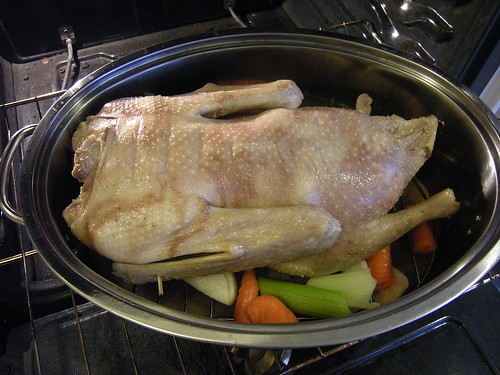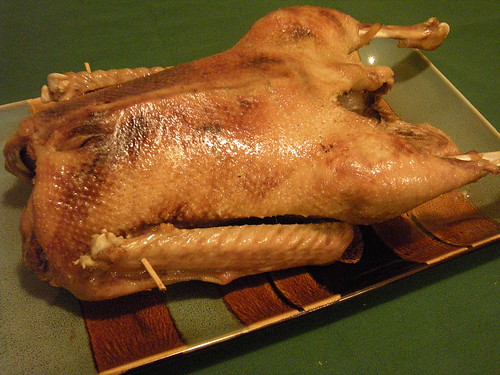 I finally did it. I've been talking about it for years. I finally cooked my Christmas Goose. Never mind that I didn't get around to it until January 11, he was still my Christmas Goose.
I finally did it. I've been talking about it for years. I finally cooked my Christmas Goose. Never mind that I didn't get around to it until January 11, he was still my Christmas Goose.I bought a 10 pound Schlitz goose from a local meat market. Turns out Goosey is not local at all but they claim they are free range. Schlitz does offer a no-antibiotics brand of goose, indicating that their "plain" geese are treated but I still suspect that geese are a bit more humanely treated than most other fowl. I paid six dollars a pound, but I found the same damn bird at another market for a dollar a pound less two days after I bought Goosey.
I did a lot of reading over the last few months to figure out how to cook a goose. I read this article in the New York Times from December 2008, and this one from NPR in December of 2007 and this one from the Schlitz people themselves. In the end I decided to use Julia Child's method from The Way to Cook. It's a steam-roast method that sounded like the best way to get the fat out in a useable form and still have a tasty bird to eat. Speaking of fat... the first step when wishing to prepare a goose is to buy a new bottle of dish soap. Holy dear lord are they greasy lil buggers! :) From the moment I opened the plastic bag until well into the clean up and leftover-eating process I was up to my elbows in goose grease. On the upside, my hands have never been so soft ;)
 Here is Goosey right out of the bag. I removed close to two cups of fat pods from inside the cavity and from extra trimmed skin as well as the liver, heart, neck and gizzards. I trimmed the wing ends off (look at those long wings! This ain't no chicken - he can fly!) and used those and the neck to make some stock. The giblets went into the stuffing. I do think he's a handsome little, er, big bird.
Here is Goosey right out of the bag. I removed close to two cups of fat pods from inside the cavity and from extra trimmed skin as well as the liver, heart, neck and gizzards. I trimmed the wing ends off (look at those long wings! This ain't no chicken - he can fly!) and used those and the neck to make some stock. The giblets went into the stuffing. I do think he's a handsome little, er, big bird.The first step was getting Goosey ready for his steam bath. I pricked his skin, rubbed him with lemon and salt and then put him breast up in the roaster with a couple inches of water. I put the roaster on the stovetop, brought the water to a boil and let him steam for an hour. This method allows the fat to render out and both not drown the meat and still be useable. After the steaming I drained out the liquid from the roaster and got THREE CUPS of fat!!

After the steaming I cleaned out the roaster and strewed some vegetables in the bottom. Goosey went back in, breast down, along with a cup of goose steaming liquid and a goodly splash of wine to spend two hours roasting in the oven at 350. Then the lid came off, the goose got flipped and another half hour to brown, with a little basting for good measure. More fat and liquid came out during the roasting ready to made one heck of a tasty gravy.
I used goose fat and butter to make a roux and then used the liquid from the roasting, seasoned with garlic powder and onion powder to make a gravy. Along with the meat and gravy I served an amazing Apple-Chestnut stuffing and some of my apple-cranberry sauerkraut. The consensus among the dinner guests was that goose is darn tasty, but very fatty. You really don't get much meat off a goose, but what meat you do get is very flavorful.
 The real bonus of cooking a goose is the amount of "extra" food I have. Three cups of fat, plus maybe five cups of cooking liquid and another half cup of fat from that, all the fat from the cavity to be rendered and the carcass for more stock and probably more fat. Wow! Oh, right, and all the fat I wiped up off my counter and knives and hands and cutting board... haha. Did I mention they are greasy little buggers?
The real bonus of cooking a goose is the amount of "extra" food I have. Three cups of fat, plus maybe five cups of cooking liquid and another half cup of fat from that, all the fat from the cavity to be rendered and the carcass for more stock and probably more fat. Wow! Oh, right, and all the fat I wiped up off my counter and knives and hands and cutting board... haha. Did I mention they are greasy little buggers?And for the rest of my life I get to tell the story of cooking my goose ;)
Wow. That sounds so fantastically yummy. And all that yummy fat-- what a bonus!
ReplyDeleteI'm surprised, though, that Julia Child didn't tell you to truss the bird?
Of course Julia told me to truss the bird, but I don't have any string and I am not buying anything this year so I made do. I stuck the wings in with wooden skewers and tucked the legs into the roaster to keep them close together. It worked out just fine.
ReplyDeleteAh! I see. Yeah, I've been there. "hmmm... string, string... where can I find some string?" I think once I used the little string that you pull off the end of a bag of grain... :-)
ReplyDelete